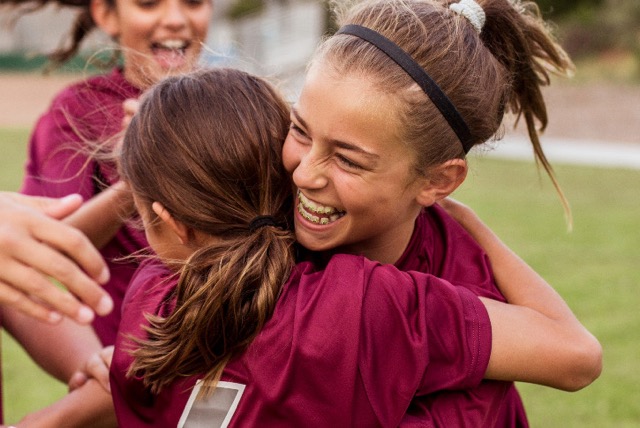There is no doubt that children and teens who choose to be involved in youth sports activities benefit significantly. Physical activity has lifelong benefits. In addition to heart health, endurance, and weight management, there are other advantages. These can include improved social interaction, self-confidence, and mental and emotional health.
There are admittedly some downsides to extensive sports participation that we should all be aware of. Some youth athletes are pursuing their chosen sport(s) not just seasonally, but year-round. Yale Medicine orthopedic surgeon David Frumberg, MD, cautions parents to be careful, as sports-related injuries affect children quite differently than adults.
Fortunately, there are ways to strike a healthy balance between adolescents joyfully pursuing their beloved sports and recreational activities and minimizing the chances of sports-related injuries. All it takes is a bit of knowledge about some of the more common sports injuries and actionable steps that you can take to help prevent injuries from happening.
Common Sports Injuries
1. Repetitive or Overuse Injuries
These types of injuries result from repetitive motion, as opposed to one-time injuries after a fall or collision. Examples are “tennis elbow” (a specific tendonitis experienced by tennis players) or “little league shoulder” (an osteochondrosis of the humeral head) that sometimes affects baseball players. Basketball players, soccer players, and football players are prone to shin splints due to high-impact running, jumping, and sudden starts and stops.
2. Knee Injuries
Anterior Cruciate Ligament (ACL) injury is common in sports such as basketball and soccer, typically due to an acute twisting and pivoting motion. This is managed with a surgery to replace the torn ligament.
Patellofemoral Syndrome can occur with any sport, particularly in adolescents who are running, jumping, or squatting during their sport. This condition may be due to the natural shape of the kneecap or an imbalance in the strength of the muscles supporting the knee.
3. Fractures
Sudden trauma in any sport or activity can result in a fracture. Stress fractures, on the other hand, are tiny breaks in the bone that result from repetitive, high-impact pounding (for example, in running) or high-impact landing (as in gymnastics or cheerleading).
4. Sprains and Strains
Many athletes will experience the occasional sprain or strain. Even if it seems to be a minor injury, it still should be taken seriously with rest, ice, and if not improving as expected, an evaluation by your doctor.
5. Concussion
News that a child may have a concussion is often very alarming to any athlete and their parent. Concussions are classified as a mild brain injury and can occur with any impact to the head. Symptoms can include dizziness, confusion, nausea, or headache. Any sign of concussion should prompt the athlete, coaches, and caregivers to immediately seek medical attention.
Tips to Prevent Sports Injury in Children
Although we certainly can’t prevent every injury, we can adopt several prevention strategies to keep kids as active as possible in sports participation.
Here are 8 tips for preventing sports injury in kids:
1. Getting a Physical Before the Season Starts
A pre-season physical is an excellent way to ensure that an athlete is fit to participate in their chosen sport(s). Most high schools require a sports physical before the student can play on the team, and an annual well exam at the pediatrician’s office includes a sports clearance exam for young athletes. That exam takes into account the patient’s medical history and physical and mental wellness to ensure the athlete is up to the rigors of the game.
If the child has had a previous injury, it’s important to review strategies with their doctor for preventing re-injury. Physicians may encourage the athlete to modify their participation if they are experiencing an unresolved injury. Such discussions are extremely helpful in encouraging overall health and prevention of serious injury.
Pediatric sports medicine specialists are fellowship-trained specifically in injury treatment and prevention in children and adolescents. Metropolitan Pediatrics is the only primary care group in the region that offers this advanced level of pediatric sports medicine for young athletes. They are trained in treating typical sports injuries, such as strains and sprains, minor fractures, dislocations, and concussions. They are experts in diagnosing overuse injuries, offering individualized treatment plans to ensure healing and prevention of further injury.
2. Use the Correct Equipment
Safety gear that fits well and is in good shape is critical. Coaches should be well-versed in all recommended protective equipment, including and not limited to:
- Helmets
- Face masks
- Mouth guards
- Footwear
- Eyewear
All equipment should be certified or licensed by the overseeing sports organization. Even if sports equipment is not directly involved in protection, it’s very important that it is in good working order. A splintered bat or cracked tennis racket can easily cause serious harm.
3. Strengthen Muscles Gradually
Sports injury prevention research indicates that muscle strength is a key factor in keeping athletes safe from many types of sports-related injury. Unfortunately, in some cases, COVID-19 has caused disruptions in children’s ability to participate regularly in their activities and maintain the strength of those young muscles. It is natural for some amount of deconditioning to occur during the off-season or after long breaks.
When starting a new strength training, it is important to practice lifting technique without weights first to ensure proper form. Then you may begin slowly adding weight. Be sure to train all large muscle groups, including the core. Aim for 2-3 sets of about 8-12 repetitions for each exercise and increase weight by no more than 10% per week.
Although many parents may have the knowledge to help their child safely improve their strength, we advise consultation with a certified physical therapist, trainer, or other healthcare professional.
ADDITIONAL RESOURCE: Learn about how you can keep your child active and healthy during COVID-19
4. Encourage Stretching
Appropriate stretching gets the blood flowing, warms the muscles, and progressively improves flexibility. The best stretches cover the full body, from the hands and wrists all the way down to the feet.
There are two kinds of stretching: static and dynamic. During static stretching, the person holds a position for a period of time, and then relaxes. Dynamic stretching involves continuous movement throughout the stretch. Examples of dynamic stretches are walking lunges or wall pushups.
Oftentimes, gradual post-injury stretching programs are prescribed to help children and teens ease back into normal sports participation. This goes a long way in helping to prevent re-injury.
5. Make Rest a Priority
Athletes of all ages require time to rest and regroup after a practice, game, or event. If a young athlete’s body does not have enough time to recover in between training or competition, an acute or overuse injury may occur. Sports diversification, or participating in multiple sports, is a great way to rest during the off-season of one sport and cross-train in another sport, which decreases the chance of injuries and burnout in young athletes.
Healthcare professionals are increasingly concerned that today’s youth athletics programs are demanding year-round practice and competition that could be detrimental to growing muscles, tendons, and bones. Our kids will reap many benefits if we do our best to plan ahead for proper rest and recuperation (but not total inactivity) during the off-season or any other breaks.
6. Prioritize Hydration
As the saying goes, “hydrate, hydrate, hydrate.” When kids are juggling school, athletic practice, and big games, it’s easy to forget about drinking enough water and other healthy beverages. Unfortunately, they can quickly reach the point of dehydration. If left unchecked, dehydration could lead to heat exhaustion. This condition occurs when our bodies are unable to cool down. Signs of this potentially dangerous condition include the following:
- Headache
- Nausea
- Vomiting
- Dizziness
It’s critically important in these cases to immediately get children out of the heat and into a cool environment.
In addition to water and non-carbonated healthy beverages, caregivers might also consider packing oranges, watermelon, or other fruit to help keep kids hydrated during games and practices. Remember that during those busy days of school, work, practice, and getting back to work again, your hydration is also important. So, pack that water bottle for yourself too!
7. Promote a Nutritious Diet
Despite consistent reminders and encouragement from healthcare providers, parents, and teachers, the goal of good nutrition can easily be overcome by the desire for unhealthy foods. Consistently getting the proper diet is particularly important during your children’s growth spurts and when they are physically active during a sport season. This is when they need extra energy to build strong bones and muscles.
Try to have a good mix of fruits, vegetables, proteins, and whole grains around the house or in the cooler in the car. For busy parents (that’s most of us), some items travel better than others, such as jerky, oranges, and nuts.
8. Follow Sports Guidelines and Proper Technique
Researchers with many organizations, such the American Academy of Pediatrics (AAP) and the American Academy of Orthopedic Surgeons (AAOS), gather up to date research on important safety topics and formulate recommendations and guidelines. Additionally, various organizations involved in promoting high standards in athletics provide information and certifications regarding proper protective equipment. Examples are the Hockey Equipment Certification Council and the Consumer Product Safety Commission, as well as the MLB creating guidelines for pitch counts in baseball.
Coaches should ensure that equipment meets these basic standards, and that they are following any specific standards for their sports.
ADDITIONAL RESOURCE: Learn about best practices in youth sports injury prevention.
When to See a Pediatric Sports Medicine Specialist
 Parents, coaches, and other caregivers should not hesitate to reach out to a pediatric sports medicine specialist when there are any questions regarding injuries and their prevention. A single call can save a lot of pain, frustration, and confusion for both parents and kids. Please contact your doctor if any of the following occur:
Parents, coaches, and other caregivers should not hesitate to reach out to a pediatric sports medicine specialist when there are any questions regarding injuries and their prevention. A single call can save a lot of pain, frustration, and confusion for both parents and kids. Please contact your doctor if any of the following occur:
- Joint swelling
- The sensation of a joint feeling unstable or appearing to “give way”
- Persistent pain during or after physical activity
- Concerns about a potential for re-injury
- Signs of heat exhaustion or concussion (please seek medical attention immediately)
Coaches, parents, and healthcare professionals can have a significant impact on successful sports injury prevention and treatment. Indeed, all of us share in the responsibility of ensuring that our loved ones are free to safely pursue the recreational and competitive sports activities that bring them joy, self-confidence, and fulfillment.
Have more questions? There’s so much more to learn from the Sports Medicine Specialists at Metropolitan Pediatrics of Oregon.










